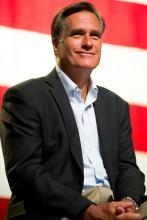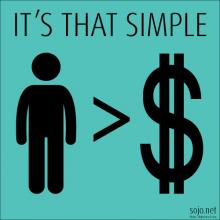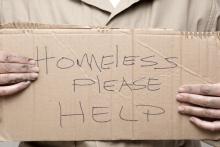Economic Justice

Most Americans who know that Mitt Romney is Mormon say the presumptive GOP nominee’s faith doesn’t concern them. But a new poll indicates there may be an “enthusiasm gap” for Romney among white evangelicals, a crucial GOP constituency.
Sixty percent of Americans know that Romney is a member of the Church of Jesus Christ of Latter-day Saints, according to a survey released Thursday (July 26) by the nonpartisan Pew Research Center. That number has barely budged since March, despite intense media focus on Romney’s faith.
Interestingly, more Americans know that Romney is Mormon than can correctly identify President Obama as Christian (49 percent).
Although most Americans say it is important for a president to have strong religious beliefs, party affiliation -- rather than religion -- drives voter preferences, Pew found.

A few weeks ago, members of the House spoke out against the House Agriculture Committee’s vote to cut SNAP benefits to working class Americans. On Wednesday, Sen. Tom Harkin (D-Iowa) rallied on the Senate-side to restore balance to the budget debate and avoid sequestration in conjunction with a report on the effects of such cuts.
The premise of the current debate is that all the cuts have to come from the non-military, discretionary budget. Harkin reported that since we last had a balanced budget (Clinton-era), discretionary funds have risen 0 percent as opposed to a 73 percent increase in the Pentagon budget.
We have two sets of rules, he said. One set for the rich, and another set for the rest of America. This equals out to tax cuts for the rich and budget cuts for the poor and middle class.

Former First Lady Laura Bush spoke with ABC News, expressing the importance of foreign aid and programs like the President's Emergency Plan for AIDS Relief (PEPFAR). In light of some in theTea Party calling to eliminate aid completely, the former First Lady said she thinks others don't realize how miniscule the amount actually is.
She said her husband President George W. Bush started the program because millions were dying in Africa from the epidemic.
"It would've been a crime I think to know that we had the capacity of helping people around the world live and not do anything about it.," Bush said.

Living in poverty has always been a struggle, but in Alabama being poor could land you in prison. According to a recent story in The New York Times, Alabama resident Gina Ray was locked up for over a month because she couldn’t pay fees and fines related to minor traffic offenses. Speeding while poor shouldn’t land someone in jail. This punishment doesn’t fit the crime.
Why would such morally outrageous penalties be imposed for such minor violations? Because criminal justice has become big business. Private companies are making millions of dollars running prisons, administering probation systems, and providing health care to those living behind bars.
Earl Ofari Hutchinson writes for The Huffington Post:
USA Today reports on a new study by the Annie E. Casey Foundation, called Kids Count:
The well-being of American children looks to be a mixed bag, with gains in academic achievement and health offset by growing economic distress, a new study finds.
Employee rights activists Mary Kay Henry and Christine L. Owens write for CNN:

Forget Wall Street. Today's "best and brightest" are heading to California's Silicon Valley and New York's Silicon Alley, and to a few other tech-startup hot spots.
Thousands of aspiring engineers, web developers, designers and marketers live in dormitories, work in open-floor bullpens, attend coding competitions to enhance their skills, and work hours that defy body chemistry. It sounds like fun.
Some work on projects that make a positive contribution to society; some are coding games, entertainment apps, and schemes to monetize friendships.
They take stock for pay and wait for the magic letters "IPO" to appear. Meanwhile, their employers fight for their loyalty with free food and party-on office cultures.
The brass ring they chase looks like Marissa Mayer, the 37-year-old former Google star who was tapped to lead Yahoo out of its extended doldrums. Like any public person, Mayer is painted in stark colors: as both immensely talented and merely lucky, an inspiring leader and a rude monster, likely to succeed and sure to fail.
Reuters reports:
"Senators are planning to introduce a bipartisan bill on Monday to give the country's securities regulator the authority to seek tougher fines for alleged Wall Street criminals.
Scott Keys reports for ThinkProgress:
"One of the most conservative congressmen in the country stepped up to defend Huma Abedin, a top aide to Secretary of State Hilary Clinton, and the rights of all Muslim-Americans yesterday against Rep. Michele Bachmann’s (R-MN) spurious accusations that she is affiliated with the Muslim Brotherhood, calling them 'the wrong thing to do.'”
During a town hall held by Rep. Jim Sensenbrenner (R-WI) on Sunday, a constituent lauded Bachmann’s anti-Muslim witchhunt about a supposed Muslim Brotherhood infiltration of the U.S. government and called on her congressman to support her efforts. Sensenbrenner instead used the opportunity not only to defend Abedin, but to advocate for the larger notion of religious pluralism in America and a separation between church and state."
Read more about Rep. Sensenbrenner's response here
On Friday, The New York Times reported:
"Moshe Silman, the desperately indebted Haifa man who set himself aflame last weekend as part of a social justice protest in Tel Aviv, died Friday from the second- and third-degree burns over 94 percent of his body.
In the year since 400,000 people filled Tel Aviv’s Rothschild Boulevard last summer, setting off a national protest movement, Mr. Silman, 57, had become a fixture of demonstrations in Haifa. His self-immolation stunned but also galvanized the protest movement, which had been struggling to find its footing."
Learn more here

Maybe someone pursuing a Ph.D. in Liturgical Theology and Ethnomusicology is shouldn't be the one to offer this reflection.
Heck, maybe a Ph.D. in Mechanical Engineering or in Astrophysics would be a wise economic choice. I can't say.
I've been mulling over some of the news stories out there hyping either end of the (political?) reality of spending more money (and time, let's not forget time) on higher education. It leads me to a couple of questions:
Does the present rate of student debt have a snowball's chance in Tartarus in being repaid? Will the students, especially the so-called "nontradtional student" like myself, actually see a return in their investment?
If you believe NPR, the answer may be "no."
EDITOR'S NOTE: Each month, Sojourners send out a Faith & Justice Newsletter to folks who are interested in intersection of faith and social action. This month, we pulled content from the magazine and our blogs relating to the corruption of the common good. Enjoy.
This year’s election cycle is expected to cost more than $6 billion -- the most expensive in U.S. history. During election years, members of Congress spend on average 40 to 70 percent of their time fundraising. One quarter of one percent (.25 percent) of donors provided two-thirds of all the campaign cash spent during the 2010 election. In a recent article for Sojourners, Nick Penniman argues the problem is only going to get worse.
This influx of campaign cash and the influence of special interests in Washington should cause even the most idealistic citizen to ask whether our politicians have completely lost sight of the common good. If the basis of democracy is each person having an equal voice in government and having her or his interests weighed equally by elected officials, then democracy in the United States appears to be profoundly broken.
Christians need to wrestle with these questions and discern how we’re called to respond. While our hope resides firmly in Jesus Christ, we can’t ignore the power of government to protect the poor and improve the lives of millions. The command to love our neighbor as ourselves means we cannot ignore the corruption of the common good.
Many of us take great care of where our food comes from, whether it is organic and has been treated humanely. But do we take the same care over the workers who grow and pick that food? Apparently not, according to Salon:
The food industry employs one in five private sector workers. Yet only an estimated 13 percent of those workers make a living wage. Thanks to lobbying by the National Restaurant Association (once led by Herman Cain), the national minimum wage for tipped workers is $2.13 per hour. Many warehouse and farm workers are paid by the piece, which can amount to even less. And so, in a situation riddled with irony, food-system workers rely on food stamps at double the rate of rest of the U.S. workforce.
The Associated Press reports on Presidential candidates attempts to sway the middle classes, and the lack of clarity about just who the middle class actually are:
In a recent speech, President Barack Obama referred to the "middle class" 14 times, defining it as a family that makes up to $250,000 a year. Republican challenger Mitt Romney has looked at it from the other direction, saying that someone who falls into poverty "is still middle class."
In the fuzzy labels and loose speech of this political season, "middle class" has ballooned to cover just about everyone. So what does the term really mean?
There's no official definition.
If anything, a slew of economic data suggests a middle class that's actually shrinking. Mid-wage manufacturing and other jobs are disappearing due to automation and outsourcing, while lower-income positions and poverty spike higher. The White House's chief economist, Alan Krueger, said in January that the middle class fell from 50 percent of U.S. households in 1970 to 42 percent in 2010, as more families moved to the extreme ends of income distribution.
But it's not just about economic ranges. And politicians are not bound by such gauges anyway.
Learn more here
Writing for The Nation, Bryce Covert examines how state-level opt outs of Medicaid expansions will affect women:
"The Medicaid expansion is a crucial component of the law’s overall goal of extending coverage to over 30 million uninsured Americans by 2019, covering almost half of the total number of people the bill promised to insure. Originally, the law included a provision that the federal government could take away all of a state’s Medicaid funding if it refused to go along with the expansion, which all but ensured participation. But the Court ruled that such a maneuver was unconstitutional. Just a few days after the decision was announced, seven Republican governors said they would flat-out reject the money to expand Medicaid rolls, with at least eight more looking to follow suit. More have said no since then.
This could create a no-man’s land for those who earn less than 100 percent of the federal poverty line, making them ineligible for tax subsidies to help them buy insurance, but don’t qualify for their state’s (unexpanded) Medicaid program. These Americans are surely struggling to get by, but not quite enough to get health coverage promised to those above and below them."
Read more here
Writing for Newsweek Magazine, Joel Kotkin wonders if the Millennial generation will be remembered as the "screwed generation:"
"Today’s youth, both here and abroad, have been screwed by their parents’ fiscal profligacy and economic mismanagement. Neil Howe, a leading generational theorist, cites the “greed, shortsightedness, and blind partisanship” of the boomers, of whom he is one, for having “brought the global economy to its knees.”
How has this generation been screwed? Let’s count the ways, starting with the economy. No generation has suffered more from the Great Recession than the young. Median net worth of people under 35, according to the U.S. Census, fell 37 percent between 2005 and 2010; those over 65 took only a 13 percent hit.
The wealth gap today between younger and older Americans now stands as the widest on record. The median net worth of households headed by someone 65 or older is $170,494, 42 percent higher than in 1984, while the median net worth for younger-age households is $3,662, down 68 percent from a quarter century ago, according to an analysis by the Pew Research Center."
Read more here

My students had questions about the central character in the story Fly Away Home written by Eve Bunting and illustrated by Ronald Himler. And even as 2nd graders, they knew something about the problem.
"Homelessness is mean," said James.
"I pass the Salvation Army on my bus on the way to school every day. I know homeless people sleep there," Billy added.
Fly Away Home tells the story of a boy who lives in an airport with his dad because they have lost their home. They move through the terminals to avoid being noticed by passengers. The story places you in the boy’s shoes and helps you see the world through his eyes. You feel the pain of the dad who can no longer provide a home for his family. You experience what it’s like to have all of your possessions in two blue bags. This is just the right book to help students and teachers think about how we view people who are homeless.
After reading the story to my students, I asked a few questions about homelessness.

Every day, millions of children go hungry. But it doesn't have to be that way.
- Hunger is the world's No. 1 health risk, causing more deaths annually worldwide than AIDS, malaria and tuberculosis combined.
(Source: World Food Program) - One in seven people in the world will go to bed hungry tonite.
(Source: World Food Program) - There are more hungry people in the world (925 million) than the combined population of the United States, Canada and the European Union (841 million)
(Source: World Food Program)
Find out about the causes of hunger — and the solutions — in a new video from World Vision Australia (with music by Gotye) inside the blog...
Ever wondered how the poverty rate has changed over the years? And how that breaks down by various demographic categories? You could spend several hours poring through the annual reports by the Census Bureau and find all the data.
Here’s an easier (and more interesting) way. Our friends at Demos, an organization that “combines research, policy development and advocacy to influence public debate and catalyze change,” have created a series of interactive graphs that can answer all your questions.
Tracking American Poverty & Policy contains the data on the U.S. poverty rate annually from 1967 to 2010, including the rate of those in “deep” poverty and those near poverty when you zoom in on the graph. Then follows a set of graphs for the same time period by race, gender, age, educational level, and family; with the same three breakdowns.
It’s a useful resource for historical data on poverty, and it’s fun to play with the graphs to find the data.